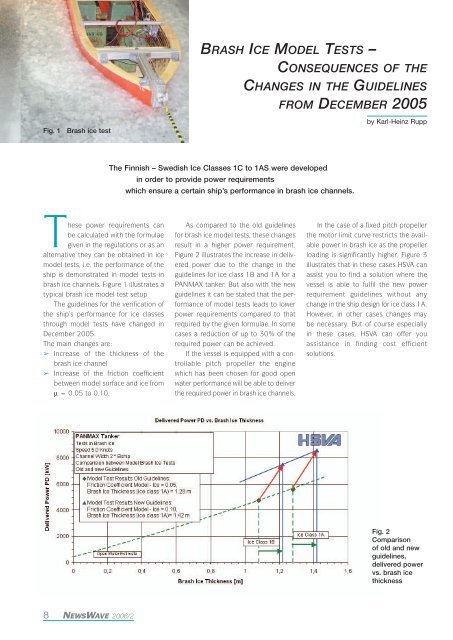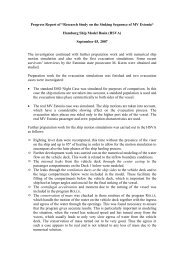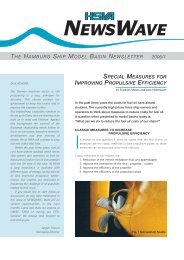Create successful ePaper yourself
Turn your PDF publications into a flip-book with our unique Google optimized e-Paper software.
Fig. 1 Brash ice test<br />
These power requirements can<br />
be calculated with the formulae<br />
given in the regulations or as an<br />
alternative they can be obtained in ice<br />
model tests, i.e. the performance of the<br />
ship is demonstrated in model tests in<br />
brash ice channels. Figure 1 illustrates a<br />
typical brash ice model test setup<br />
The guidelines for the verification of<br />
the ship’s performance for ice classes<br />
through model tests have changed in<br />
December 2005.<br />
The main changes are:<br />
➢ Increase of the thickness of the<br />
brash ice channel<br />
➢ Increase of the friction coefficient<br />
between model surface and ice from<br />
µ = 0.05 to 0.10.<br />
8 <strong>NEWSWAVE</strong> 2006/2<br />
BRASH ICE MODEL TESTS –<br />
CONSEQUENCES OF THE<br />
CHANGES IN THE GUIDELINES<br />
FROM DECEMBER 2005<br />
The Finnish – Swedish Ice Classes 1C to 1AS were developed<br />
in order to provide power requirements<br />
which ensure a certain ship’s performance in brash ice channels.<br />
As compared to the old guidelines<br />
for brash ice model tests, these changes<br />
result in a higher power requirement.<br />
Figure 2 illustrates the increase in delivered<br />
power due to the change in the<br />
guidelines for ice class 1B and 1A for a<br />
PANMAX tanker. But also with the new<br />
guidelines it can be stated that the performance<br />
of model tests leads to lower<br />
power requirements compared to that<br />
required by the given formulae. In some<br />
cases a reduction of up to 30% of the<br />
required power can be achieved.<br />
If the vessel is equipped with a controllable<br />
pitch propeller the engine<br />
which has been chosen for good open<br />
water performance will be able to deliver<br />
the required power in brash ice channels.<br />
by Karl-Heinz Rupp<br />
In the case of a fixed pitch propeller<br />
the motor limit curve restricts the available<br />
power in brash ice as the propeller<br />
loading is significantly higher. Figure 3<br />
illustrates that in these cases <strong>HSVA</strong> can<br />
assist you to find a solution where the<br />
vessel is able to fulfil the new power<br />
requirement guidelines without any<br />
change in the ship design for ice class 1A.<br />
However, in other cases changes may<br />
be necessary. But of course especially<br />
in these cases, <strong>HSVA</strong> can offer you<br />
assistance in finding cost efficient<br />
solutions.<br />
Fig. 2<br />
Comparison<br />
of old and new<br />
guidelines,<br />
delivered power<br />
vs. brash ice<br />
thickness





